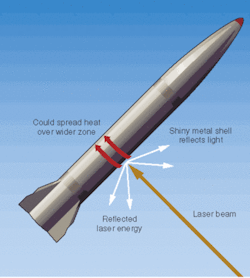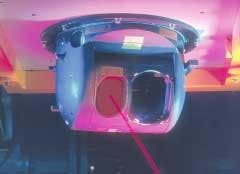In the military world, every measure has a countermeasure, designed to impair the operation of the opponent's equipment. Both offense and defense need to know what countermeasures are available—the offense to try to foil them with counter-countermeasures, and the defense to try to deploy them for protection. Countermeasures can be active, like a laser or flare that blinds a heat-seeking missile, or passive, like a reflective surface on a missile that might be targeted by a laser weapon.
Optical countermeasures have become increasingly important as lasers and optical systems are integrated into military arsenals. Their purposes include protecting military equipment and personnel from dangerous laser beams, and blocking optical and infrared (IR) systems used to guide weapons to their targets. The latest trend is to deploy countermeasures to protect civilian systems—and the top priority is equipping airliners with equipment to protect them from attack by terrorists armed with shoulder-launched missiles.
Laser-weapon countermeasures
Critics of high-energy laser weapons have long warned that simple countermeasures could prevent the weapons from delivering lethal energy, particularly for ballistic missile defense. One simple countermeasure would be covering missiles with highly reflective metal skins to reduce the fraction of incident energy they absorb. Ballistic missiles could be given a spin about their axis, so laser energy would be spread around their circumference rather than concentrated on a single vulnerable spot (see Fig. 1). Stationary or slow-moving targets could be coated with ablative materials that evaporate, forming clouds that absorb or scatter laser light before it can reach the target.
The potential effectiveness of these techniques remains controversial. Military officials say that it would be difficult to make missiles spin along their axes. Surface effects are more complicated. Reflective surfaces certainly would increase the laser power needed for lethality, but some energy is always absorbed, and surface effects in a fast-moving missile can be quite complex. The effects of ablative layers also are complex.
Laser eye protection and warning devices
Programs to develop laser weapons specifically for destroying or damaging sensors appear to have died out or gone underground, presumably because the ban on lasers built to blind soldiers could be interpreted as covering antisensor lasers. Even if that work has really stopped, standard laser rangefinders and target designators can cause serious eye damage, particularly to soldiers using binoculars or other optical equipment. This has led the Pentagon to develop laser eye protection. As in the laboratory, a key problem is balancing protection with usability, and soldiers are no different from scientists in not liking clumsy goggles.
The Pentagon's approach has been to include laser filters in protective goggles designed to protect soldiers from projectiles and other battlefield hazards. Current systems have a pair of laser lenses—one blocking three lines that can be used only in daylight, and a two-line filter usable in dimmer light. The new Military Eye Protection System developed by the Army Soldier Systems Center in Natick Massachusetts has a set of three interchangeable lenses made of impact-resistant polycarbonate, one clear, one for sun protection, and one to block multiple near-IR laser lines used in rangefinders and target designators (see Fig. 2).Warning systems can detect illumination by a laser rangefinder or target designator. One example is the AN/AVR-2 Laser Detecting Set used in a variety of U.S. helicopters and transport aircraft. It has four sensor heads, which scan all 360° in the plane of the aircraft and a range of ± 45° in elevation. A central processor compares sensor inputs, processes the signal, and passes information to the aircraft's radar detector. Other systems have been developed for other aircraft, and for use on the ground. The sensors can either alert the operators so they can take evasive action or turn on countermeasure systems that can defeat the threat.
Aircraft defense countermeasures
Optical countermeasures have also become important to protect aircraft from heat-seeking missiles, particularly the cheap and widely available shoulder-fired MANPADS (man-portable air-defense systems) first developed in the Vietnam era. The first generation of these missiles used simple uncooled IR detectors to guide the missile to the hottest spot in view, the tail pipe of the aircraft's jet engine. That simple guidance system can be defeated by firing a flare that burns at 1200°C to 1400°C from the aircraft so the missile locks onto the flare. By the time the flare burns out, the plane has moved out of the missile's narrow field of view, so the missile can't find its target.
To overcome flares, a second generation of heat-seeking antiaircraft missiles was developed. They use narrowband IR detectors that spot specific IR signatures found in exhaust flumes but not flares. They also have enhanced navigation systems that change their target from the exhaust to the aircraft itself when they come within striking distance. These changes let the missiles be fired at an aircraft from a wider range of angles than early models, which required the soldier to have the hot end of the engine in view.
A new generation of countermeasures has been developed to foil these second-generation MANPADS. They aim specially modulated beams from lasers or lamps at the missile, fooling its guidance system into thinking the aircraft is headed in a different direction. The modulation techniques are classified, and depend on design of the guidance system.
The Pentagon has been developing Advanced Threat Infrared Countermeasures (ATIRCM) since the 1990s. The goal was a set of modularized equipment that could be assembled into systems for use on a variety of aircraft from all three armed services, and possibly for use on tanks as well. Aircraft would be equipped with passive sensors to look for missiles, which would trigger deployment of the countermeasures and direct them at the oncoming missiles. Sanders Associates—now part of BAE Systems—won the original contract for the AN/ALQ-212 ATIRCM system. Their 140-lb system includes IR laser and lamp jammers, and is used on helicopters and large aircraft.
Northrop Grumman lost that competition, but continued developments of its own version, the Directional Infrared Countermeasures (DIRCM) system, and eventually landed a contract to build systems designated AN/AAQ-24 for the U.S. Special Operations Command, Britain, and Australia. Northrop Grumman describes the heart of its DIRCM system as a solid-state multiline laser with eye-safe output. It's actually an optical parametric oscillator pumped by an Nd:YAG laser that generates a number of wavelengths longer than 1.5 µm. The laser is mounted in an external pod that directs the beam into a turret equipped with a fine-tracking sensor that follows the missile and aims the laser beam at it to break the missile's lock on the aircraft.
"The system is entirely passive until it sees a threat missile," says Jack Pledger, director of IR countermeasure business development at Northrop Grumman. The laser transmits simultaneously on the different bands used by several types of missiles "so we don't have to know what kind of missile it is," he adds. Units are now deployed on C-17 heavy cargo planes.
Airliner defense
The Department of Homeland Security (DHS) is keen to adapt the same IR countermeasures technology to protect civilian aircraft from terrorists who might lurk near airports with MANPODS. Last year DHS asked contractors for proposals, and in January it awarded three $2 million contracts for technology demonstrations. Northrop Grumman and BAE Systems will develop commercial versions of their military systems, while United Airlines is heading a group of companies working on an IR decoy system. The DHS goal is a system that will cost less than $1 million to install on an airliner.
The target price should be easy to meet, but the challenge is to adapt military technology to meet the way commercial airlines operate, says Pledger. Commercial planes don't maneuver as much and don't spend as much time at elevations below 15,000 feet, where they're vulnerable to MANPODS. That reduces the number of missile sensors and transmitters that have to be mounted with clear fields of view to detect potential incoming missiles. However, civilian craft fly continuously and undergo periodic overhauls only ever year to 18 months, much less often than military aircraft are maintained, so the package has to be made user-friendly for airlines.
Another Northrop Grumman division—the former TRW—has proposed defending airliners from MANPODS with high-energy laser weapons installed at airports (see Fig. 3). The Hornet concept evolved from the deuterium-fluoride Tactical High Energy Laser (THEL), which shot down tactical missiles in tests at the White Sands Missile Range and was developed by TRW built for a joint U.S.-Israel program. Hornet could use the airport radar to spot and track missiles, which differ dramatically from slower, larger, and cooler aircraft. Expected to cost in the low tens of millions of dollars, Hornet could be used against threats other than heat-seeking missiles. Northrop envisions the laser as part of a layered defense system that would include aircraft countermeasures. But DHS is far from enthusiastic, and it remains to be seen what airport neighbors would think of high-energy chemical lasers scanning the skies just over the fence.Outlook
Although optical countermeasures are not widely deployed on military equipment, they fit logically into the world of electronic warfare. Optical countermeasures merely shift the frequency range from microwave radars and jammers to the optical range. As guidance systems grow more sophisticated, the countermeasures deployed against them are sure to be refined as well. Indeed, work is already under way on enhanced versions of optical jammers.
The new frontier of homeland security is harder to fathom. Military technology must be reengineered to meet commercial requirements. Security requirements must be carefully assessed. What are the real risks, and what types of aircraft should be equipped? Where do we draw the line between jumbo jets flying to hot spots of terrorism and the smallest commuter planes flying in middle America? And who will pay the bills when the airline industry is in sorry financial shape?
About the Author
Jeff Hecht
Contributing Editor
Jeff Hecht is a regular contributing editor to Laser Focus World and has been covering the laser industry for 35 years. A prolific book author, Jeff's published works include “Understanding Fiber Optics,” “Understanding Lasers,” “The Laser Guidebook,” and “Beam Weapons: The Next Arms Race.” He also has written books on the histories of lasers and fiber optics, including “City of Light: The Story of Fiber Optics,” and “Beam: The Race to Make the Laser.” Find out more at jeffhecht.com.



